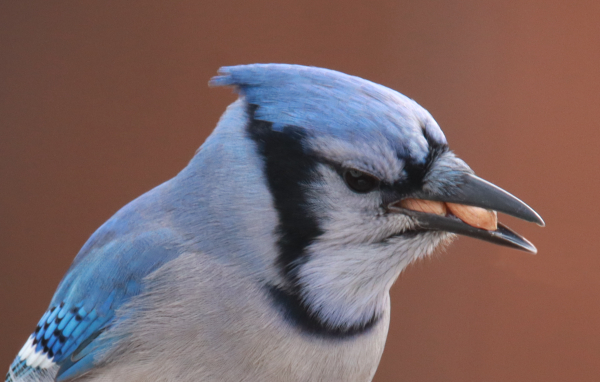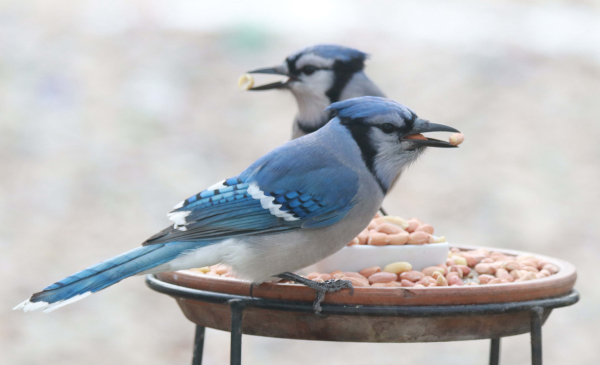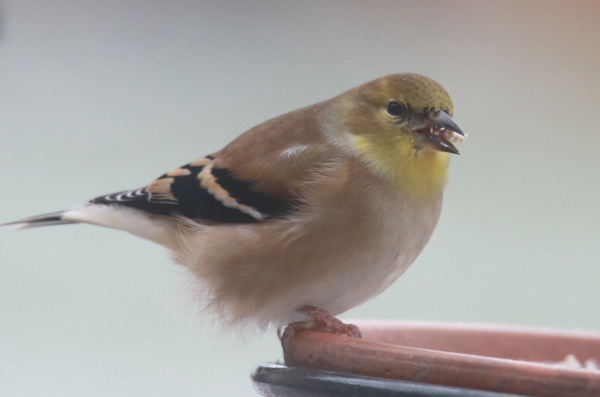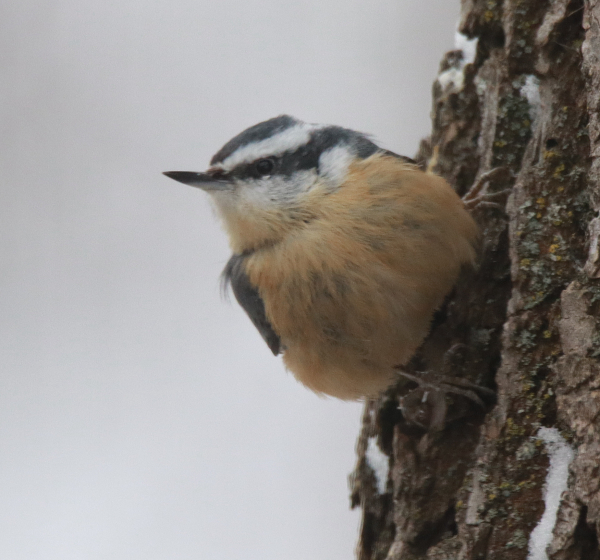
Blue Jays were the most colorful and fun to photograph, especially when they offered close views and arrived in multiples of 2 to 4.


A lone Redpoll was the first of its kind to arrive, but it was only present Saturday. The overcast sunlight was quite subdued but it eliminated the need to be concerned about contrasting shadows in the photographs.

American Goldfinches added to the surprising variety of birds feeding at my tube feeder and platform feeder.

One of the first 2 Red-breasted Nuthatches to appear at my feeding station was photographed on the trunk of an adjacent ash tree.
|
Saturday morning was filled with surprises! For starters, the season’s first snow covered the ground in a bright white background that emphasized the elements of my feeding station and the birds that were much more active and varied than usual. In fact, there were 5 more surprises to witness – a first of fall Redpoll, Red-breasted Nuthatch, and Cedar Waxwing, plus a Dark-eyed Junco that was the first junco to feed on my platform feeder. It was also the first time 4 Blue Jays arrived at once – how exciting! This was indeed the kind of payoff I’ve been hoping for, and the kinds of surprises you can look forward to at your feeders.
It was great to watch the action, and it stirred me to try a few photos in the midst of new birds arriving and more regular visitors too, including White-breasted Nuthatches and House Finches, plus American Goldfinches that arrived a couple days before. The new snow provided a white canvas for photographs that turned out pretty well, and I was drawn away from my regular work to spend an hour or so photographing birds at one of the feeders and adjacent trees and perches.
My feeders include a Squirrel Buster tube feeder filled with shelled sunflower seeds and a small percentage of shelled peanut halves, a suet feeder filled with a hot pepper suet cake to repel the occasional squirrel, and my newly converted platform feeder that held fresh water the previous day, but ice formed overnight, so peanut halves and shelled sunflower seeds covered the ice. The white cup filled with seeds and peanuts that I placed in the center of the bird bath to get the Blue Jays to approach my feeding station was now frozen into place and became a favorite of the jays and nuthatches. Never fear though, my heated bird bath was plugged in and providing water during the early cold snap, when the temperature dipped into the low 20s during a couple nights.
When shopping in the big city (2 hours away) last Wednesday I couldn’t find a nyjer thistle seed “sock” when I looked for one, but as usual the small finches – American Goldfinches, the Redpoll, and even the Red-breasted Nuthatches readily ate shelled sunflowers seeds – and the key to that is that they are shelled seeds. Some of the finches may not manage to break open sunflower seed shells with their tiny beak, and there are always smaller broken shelled seeds. Frankly, that helps to eliminate another feeder and an ‘unnecessary’ seed type at my feeding station.
Photographing birds at feeders provides 2 options, both equally fine – photographing birds at the feeders, and photographing birds at adjoining natural perches on tree and sumac branches. I also add a couple extra natural-looking perches in the form of branches from birch trees, a favorite Northwoods tree of mine. Photographing was pretty fast and furious for a while, with a variety of the feeder visitors seemingly taking turns gleaning their favorite morsels. As I maneuvered around my office with my camera in hand, I positioned myself to keep the snowy landscape the dominant background when photographing birds at the feeders.
I also positioned myself at different levels, dropping to a knee at times, sitting at times, and standing most often. It was all great fun, and the birds were acting in fast-forward action, which made me try my best to anticipate their movements, including head turns and take-offs. In some cases I took advantage of the background provided by a nearby juniper tree for a darker background, and the sky came into play sometimes too.
In case you are interested in camera settings, I wanted to emphasize the birds and provide as uniform a background color as possible, so used the aperture that made that most possible with my zoom lens, an f-6. That created a shutter speed that varied between 1/60 and 1/640, pretty slow, but fast enough to provide some nice window photos. Photographing through a window is never a preferred option, but it was my best option as cold as it was outdoors – and it was obvious that most of the birds weren’t very trusting when I stepped outside to fill feeders. As in any photography endeavor, I was prepared for a photo editing session to select some of the best photos of different species, and crop extraneous background to improve the best images.
It was clearly a monumental feeder watching day as I tried to do my work yet take advantage of the birds and brief snowy introduction to the winter ahead. It was especially exciting to see some new birds attracted to my feeding station to emphasize an overnight migration and a hint of things to come with a north wind still blowing. I certainly hope your late fall bird feeding season is off to a fine start, and use my good luck as incentive to keep your feeders stocked and your winter water fresh – Good Luck!
Article and Photos by Paul Konrad
Share your backyard birding experiences and photographs with The Birding Wire at editorstbw2@gmail.com